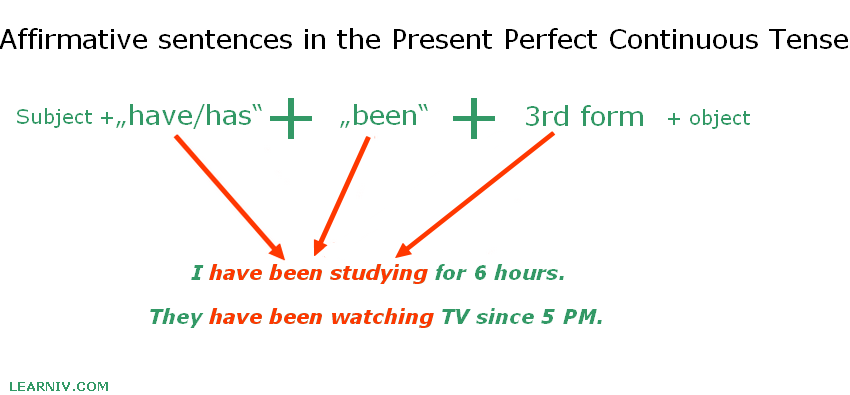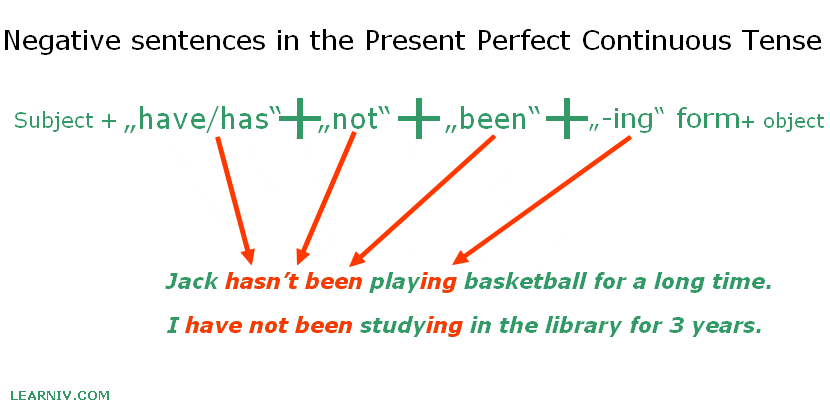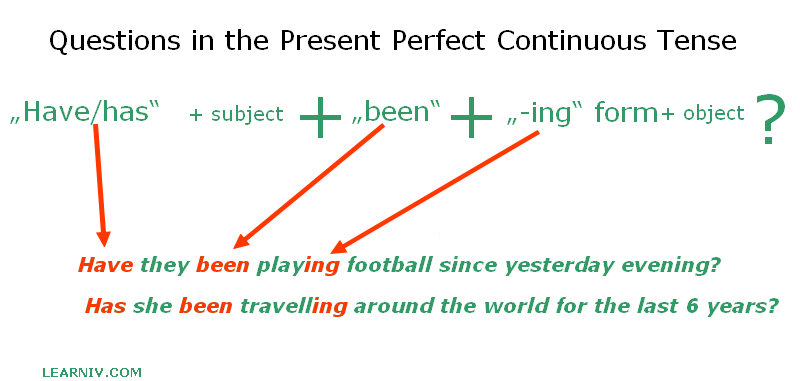The present perfect continuous tense (sometimes referred to as the present perfect progressive tense) is a special tense which talks about events in the past that last into the present. It usually emphasizes the duration or amount of time that the action has been taking place. The present perfect continuous uses two auxiliary verbs in combination with a main verb.
Look at present perfect continuous tense examples.
Construction of sentences
To construct sentences in the present perfect continuous tense we need to use the auxiliary verb „have/has“. We combine this auxiliary verb with the past participle form of the verb „to be“ and with the main verb in base form with the suffix –ing.
The present simple is not much harder than the present perfect – we just need to distinguish between the person and the number of subjects to know when to use the verb „have“ and when to use „has“ instead.
Negative sentences and questions are pretty similar in construction to affirmative sentences, which makes it easier.
When do we use the verb „have/has“?
We use the forms „have“ or „has“ of the verb when we are talking in the present perfect tense. We always have to use it as an auxiliary verb, otherwise we will not be talking in the present perfect. When do we use the forms „have“ and „has“?
Form „has“
The form „has“ is used with the 3rd person singular (He, she, it).
Example:
- He has visited her twice.
- She has watered the garden.
Form „have“
We use this form in combination with all other persons, except for the 3rd person singular.
Example:
- We have done this before.
- They have seen him this week.
Affirmative sentences in the present perfect continuous tense
Affirmative sentences in the present perfect continuous tense include three verbs. The first one is the auxiliary verb „have/has“, the second one is the past participle form (3rd form) of the verb „to be“ which is „been“, and the last one is the main verb in its base form with the suffix –ing to show the progressive aspect.
The structure of the sentences is:
Subject + have/has + been + verb(-ing) + object.
The only thing we cannot forget is the verb „been“. Without this auxiliary verb the sentence will not make sense.
Example:
- I have been studying for 6 hours.
- They have been watching TV since 5 PM.
- She has been laying in her bed since the day started.
Negative sentences in the present perfect continuous tense
To construct a negative sentence in the present perfect continuous tense we need to add the word „not“ right after the auxiliary verb „have/has“ but before the verb „been“. In negative sentences we still add the suffix –ing to the main verb in its base form. The only thing that’s changing is that we are adding the negative „not“.
The structure of the sentence is:
Subject + have/has + not + been + verb (-ing) + object.
Example:
- Jack hasn’t been playing basketball for a long time.
- I have not been studying in the library for 3 years.
- They have not been watching the whole season of ice hockey.
Questions
Questions are similar to affirmative sentences. The only thing that is changing is the word order since we put the verb „have/has“ at the front of the sentence. Once again, we use the progressive aspect –ing to describe the continuous tense.
The structure of questions in the present perfect continuous is:
Have/has + subject + been + verb (-ing) + object?
Example:
- Have they been playing football since yesterday evening?
- Has she been travelling around the world for the last 6 years?
- Have you been watching him since he started his singing career?
Present perfect versus present perfect continuous
The present perfect and present perfect continuous are both really similar. Sometimes they mean the same thing, but other times they can mean something completely different. For this reason, we need to learn when to use which tense as we use them both for finished and unfinished actions in the past.
One difference is that while the present perfect continuous tense specifies a time in the past, the present perfect is generally time neutral.
The use of the present perfect continuous focuses on the action itself. When we are using this tense, it doesn’t matter if the action was completed or not – we only care about the process. On the other hand, when we use the present perfect simple, we are referring to a completed action.
When can we not use the present perfect continuous?
How much and many
We cannot use the present perfect continuous to talk about the amount of something. If we refer to an amount of something, we must always use the present perfect.
Example:
- She has eaten 3 pizzas this morning.
She has been eating 3 pizzas this morning. – WRONG
Stative verbs
The main and biggest difference is that we cannot use the present perfect continuous with stative verbs. Stative verbs do not refer to physical actions, so we cannot use the progressive aspect here.
Example:
I‘ve been liking you. – Present perfect continuous -WRONG- I have liked you. – Present perfect
You cannot use the present perfect continuous with stative verbs. As you can see, stative verbs with the suffix –ing do not look or sound good. This is the case for every continuous (progressive) tense in English.
Live, work and study
There are three verbs which can mean the same thing in the present perfect simple and in the continuous. These verbs are: live, work and study. We can use them in both tenses and they will mean the same thing.
Example:
- I have been living in New York for 3 years.
- I have lived in New York for 3 years.
Both sentences describe the same thing. It doesn’t matter which tense we use.
Different effects in the present
A big difference is when we want to talk about things that changed in the present due to past events. We can use the same verbs in different tenses and the meaning of the sentence will be completely different.
Example:
- I have already done my chores. – Present perfect
This sentence says I have done them – they are done and I can do other things. I can go out with my friends and enjoy my time with them. - I have been doing my chores. – Present perfect continuous
This sentence means I have been doing my chores for so long that I am too exhausted to go out. Changing the tense while using the same words can completely change the meaning.
When do we use the present perfect continuous?
We can use the present perfect continuous in many situations, but all of them have to start in the past and continue into the present.
Emphasizing the length/amount of time
The present perfect continuous is used to emphasize the amount/length of time that has passed since the action started in the past.
Example:
- She has been working for hours. – Present perfect continuous
This sentence emphasizes that she has spent hours at work, which means she has been at work for a really long time. She may still be working. - She has worked for hours. – Present perfect simple
This sentence in the present perfect simple states that she has worked for hours, but she is no longer working. The action has ended.
Unfinished business
This tense is also used to talk about unfinished business. Contrary to the present perfect, we do not care if the action was completed or not.
Example:
- I‘ve been watching a TV series. – Present perfect continuous
This sentence means that I‘m still watching TV. The action has not stopped – it has carried into the present. - I have watched the TV series. – Present perfect simple
This sentence means that I have already finished watching TV. It did carry into the present, but the action is now completed.
Repeated events
This tense is also used to talk about repeated events in the past. If we want to describe an action that was happening repeatedly in the past, we will use the present perfect continuous.
Example:
- She has been seeing him. – Present perfect continuous
This sentence means that she has been seeing him repeatedly. The action of seeing him was happening again and again. - She has seen him. – Present perfect simple
This sentence means that she has seen him only once. The action was not repeated.
Non-permanent situations in the past
The past perfect continuous is also used to describe past situations that weren’t permanent – they happened only once or exceptionally.
Example:
- I have been sleeping badly tonight.
This sentence means that I have been sleeping badly only during this particular night. It is not happening every night. - I have bought a lunch.
The above sentence refers to a special event because I don’t usually buy lunch, I usually make my own at home. As such, this is a non-permanent situation.
Short-forms „have“ and „has“
Using short-forms of these verbs save us time when writing and speaking. Just keep in mind that when we are talking to an accredited person or in formal society, we should NOT USE short-forms as it is impolite. We use short-forms to talk with friends or family.
Short-forms of the verbs „have/has“ look like this:
Have
• I have been sleeping. –> I’ve been sleeping.
• They have been sleeping. –> They’ve been sleeping.
The (‘ve) represents the verb „have“, therefore we do not need to use it again in full.
Has
• She has been working. –> She’s been working.
• He has been working. –> He’s been working.
In the above the (‘s) represents the verb „has“. The meaning is the same, but it is shorter to write and say.




